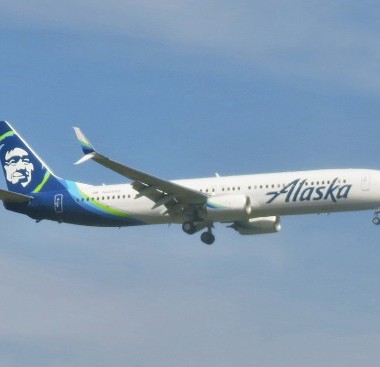S&P Global: American Airlines Group Inc. Outlook Revised
Mar 24, 2023American Airlines Group Inc. Outlook Revised To Positive On-Demand Strength; Certain Issue Ratings Raised

We expect American Airlines Group Inc. (American) will continue to improve its earnings and cash flow this year, as passenger traffic demand is assumed to remain strong amid industry capacity constraints that should support high fares.
- A softer U.S. economy and elevated jet fuel prices are notable risks to the company's operating results, and its debt maturities over the next few years are significant.
- However, we believe the company is well positioned to generate credit measures we view as strong for the rating.
- As a result, S&P Global Ratings revised the outlook on its issuer credit rating (ICR) on American to positive from stable and affirmed the 'B-' ICR.
- In addition, we raised certain issue-level ratings to reflect recent debt repayment and our updated collateral valuations.
- The positive outlook on the ICR reflects the increased potential for an upgrade later this year, as we estimate American's funds from operations (FFO)-the to-debt ratio will increase to about 15% in 2023, which is above our threshold for the rating.
TORONTO (S&P Global Ratings) March 24, 2023--S&P Global Ratings today took the rating actions listed above.
America strengthened its credit profile over the past year, and further improvement appears likely in 2023.
Strong demand for domestic passenger travel was the catalyst for the much higher earnings and cash flow the company generated in 2022, and we assume this will persist in 2023. American generated an FFO-to-debt ratio of 9% last year, near our upside threshold for a rating of above 10%. We believe America is poised for further improvement amid strong demand and industry capacity constraints that should support high fares and gradual margin improvement. We estimate FFO to debt at about 15% this year and believe the company will generate positive free cash flow that it will allocate toward debt reduction. In our view, year-over-year improvement in America's operating results could temper the risks associated with its substantial refinancing requirements over the next couple of years.
The company's available seat miles (ASMs) were up more than 20% year over year and are approaching 2019 levels--the pre-pandemic benchmark. Utilization also improved and contributed to much higher passenger revenue per available seat mile (PRASM) which mitigated the impact of historically high jet fuel prices last year. Since the pandemic, the company has deliberately shifted capacity from its lower-margin flights (that is, certain long-haul international routes) to more profitable short-haul/Sunbelt hub flights, and we believe this contributed to higher returns. American generated almost $49 billion in total revenue in 2022--an increase of almost $20 billion compared with the previous year--and an adjusted EBITDA margin of 12.5% that was comparable with that of other U.S. mainline airlines. The company's domestic operations remain by far the largest share of revenue at almost 75%, but its Atlantic and Latin American traffic has also rebounded strongly and we expect they will improve further this year.
Demand for passenger travel shows no sign of easing in the near term.
In our view, there is material pent-up demand for passenger travel following the pandemic that has yet to be fully realized, and we incorporate this into our higher revenue and earnings estimates for American. Airline industry revenues in the U.S. increased sharply from 2020 lows but have not kept pace with economic growth. Although the shortfall (relative to nominal GDP) has narrowed, we believe this presents material future revenue upside for the industry and America, the largest U.S. airline as measured by ASMs. Moreover, hybrid work presents greater potential flexibility to travel, and S&P Global Economics forecasts real consumer spending will remain positive in 2023 (albeit well below 2022 levels).
We expect higher capacity will spur growth in the company's operating results and more than offset cost pressures mainly from elevated jet fuel prices and rising labor costs. A shortage of trained pilots and other staff (such as maintenance, air traffic controllers), as well as delays in narrow-body aircraft deliveries, will likely persist at least into next year. In our view, the lack of excess capacity should limit downside to fares and our estimates for America.
America's debt levels are significant but improving credit measures should lessen refinancing risk.
Our ICR on American reflects the airline's substantial debt and large maturities that present refinancing risk. The company's S&P Global Ratings-adjusted debt was relatively stable in 2022 at about $39 billion. American reduced its gross debt by about $2.7 billion last year, although mostly from cash on hand (which we net to derive adjusted debt) and a lower pension and post-retirement liability. The company plans to further reduce debt, as it faces scheduled debt payments of $3.0 billion this year, $3.5 billion in 2024, and about $7.5 billion in 2025.
America has a solid cash position of about $9 billion, which provides some financial flexibility (although it must hold at least $2 billion of liquidity as a requirement under multiple debt agreements) to address near-term maturities if needed. In addition, the company demonstrated capital markets access in February 2023, which we viewed favorably given its future refinancing needs. However, yields have since increased (by more than 10% in the month since America issued secured notes) and we acknowledge the potential for credit market volatility to persist.
Our estimates for America's credit measures remain highly sensitive to relatively small changes in our assumptions.
The potential risks and uncertainties associated with a softening U.S. economy, and looming debt maturities limit the upside to our ICR on America for now. The airline industry is highly cyclical and historically sensitive to changing economic conditions. Weaker-than-expected demand or fares can have a significant adverse effect on credit measures--particularly if jet fuel prices remain high. The company also faces structurally higher labor costs (as do other U.S. mainline carriers) that increase the importance of capacity growth to mitigate overall inflationary pressures on margins.
The S&P Global Ratings energy team assumes a full-year average price of $85 per barrel (/bbl) for West Texas Intermediate (WTI) and $90/bbl for Brent crude oil in 2023, which is modestly lower than the 2022 average. However, the increase in the spread between refined jet fuel and oil prices was unprecedented last year and remains elevated from a historical perspective (and likely will remain highly volatile). We consider the potential that softer demand that could arise from a U.S. recession might limit America's ability to cover sustainably high jet fuel costs with fares.
We estimate that all else being equal, flat year-over-year PRASM in 2023 (compared with our estimate in the low-single-digit area) in 2023 leads to an FFO-to-debt ratio below 10% (our upside threshold for the rating). The impact on FFO to debt is similar if the company realizes an average jet fuel price that is slightly above (less than 10%) our assumption in 2023. We acknowledge several potential offsetting factors could mitigate the effect on America's credit measures; for example, ticket prices have historically tracked changes in fuel prices. However, it demonstrates the high sensitivity of American's earnings and cash flow to relatively small changes in our assumptions.
The positive outlook reflects our view that America will generate credit measures that we view as strong for our ICR, including FFO to debt of about 15% in 2023 and 2024. We expect the company will generate higher revenue and earnings, led by added capacity amid continuing favorable industry supply and demand fundamentals that support strong fares and gradual margin improvement. Higher earnings and relatively modest capital expenditures (capex) should lead to free cash flow generation available for debt repayment.
We could raise our rating within the next 12 months if we gain further conviction that America will meet our estimates for its FFO-to-debt ratio to exceed 10% in 2023 and 2024. In our view, this would most likely follow the seasonally stronger summer months in the U.S. At that point, we believe we will likely have enhanced visibility regarding the potential impact of a softer U.S. economy on the company's operating results, liquidity, and refinancing risk.
We could revise the outlook to stable if, over the next 12 months, we expect America will maintain an FFO-to-debt ratio near 10% in 2023, with low prospects for improvement in 2024. This might occur if we expect the effects of a weaker-than-expected U.S. economy will limit growth in its revenues, or the company's consolidated ASM exceeds our estimates and leads to lower-than-expected margins and earnings. Future issues regarding the company's ability to refinance its future debt maturities could also constrain the rating.
E-3, S-4, G-2
American Airlines, like other airlines, faces long-term risk from potentially increasing environmental regulation of greenhouse gases. Its average fleet age of about 12 years is above the global average but younger than those of close peers Delta and United Airlines Inc. Following years of heavy capital spending, American's fleet is in satisfactory shape over the medium term. American's financial condition remains pressured by the effects of the pandemic (due to high debt, but the effect is easing). The company added debt to maintain liquidity, and its earnings, although improving, are still below pre-pandemic levels (the ICR on American is three notches below pre-pandemic levels, but the outlook is now positive).
Similar Stories

Lufthansa Cargo and Maersk launch cooperation to support decarbonization of airfreight
View ArticlePort Authority of New York and New Jersey airports see spookily spectacular surge in October
Port of New York and New Jersey surpasses 700,000 TEUs for eighth consecutive month
View Article
airBaltic Cargo partners with cargo.one to accelerate and enhance its digital sales
View Article
Chapman Freeborn agrees partnership with Portuguese multimodal logistics specialist
View Article
Cathay is ready for the commissioning of the three-runway system at Hong Kong International Airport
View ArticleUnited Airlines Holdings Inc. upgraded To ‘BB’; outlook stable
• United Airlines Holdings Inc. is on track to generate credit measures in line with our previous upside rating threshold this year, and we expect improvement in 2025. • The…
View ArticleGet the most up-to-date trending news!
SubscribeIndustry updates and weekly newsletter direct to your inbox!





